|
|
|
|
|
|
|
Kootenay National Park is part of a vast park complex protecting the magnificent wilderness of the Rocky Mountains along the British Columbia-Alberta border. Situated just southwest of Banff National Park, it is bordered by Yoho National Park to the north, and by Mount Assiniboine National Park to the south.
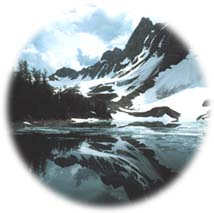
In recognition of the area's importance the entire complex of parks (Kootenay, Yoho, Banff, Jasper, Mt. Robson, Mt. Hamber, and Mt. Assiniboine) has been designated by the United Nations as the Rocky Mountain Parks World Heritage Site.
The Kootenay Parkway, a highway running the length of the park from north to south, is an excellent way to look into the 140,600 ha (350,000 acre) of mountain wilderness that make up Kootenay National Park. Since the highway makes it so easy to see sheep, deer, and mountain goats, as well as a panorama of hanging glaciers and forested valleys, many people simply drive through the park without stopping. As a consequence this park has fewer visitors than the more well-known Rocky Mountain parks. This means those who do stop to enjoy the many pleasures of Kootenay will have a wilder experience than is possible in more developed Banff or Jasper Parks.
|
|
One of Kootenay's most intriguing feature is its surprisingly diverse habitat, which ranges from glaciers and alpine tundra in the north to grasslands and cacti in the south. Situated in the drier south, Radium Hot Springs is the most popular attraction of the park. A welcome and relaxing rest for weary travellers, the natural hot springs also feature fascinating pictographs left by natives who stopped to enjoy the hot waters centuries ago.
The incredible scenery, abundant wildlife, and true wilderness of the park can be experienced by camping and backpacking during the summer, or cross-country skiing and snowshoeing treks in the winter.
|
"One of Kootenay's most intriguing feature is its surprisingly diverse habitat, which ranges from glaciers and alpine tundra in the north to grasslands and cacti in the south."
|

Kootenay National Park can be accessed from the north at two places on the Trans-Canada Highway: Castle Junction in Banff National Park (by way of Highway 93 South - the Kootenay Parkway) or Golden (by way of Highway 95). A third entrance, from the south, is by way of Highway 93/95 (the two highways come together in this area) and the town of Radium Hot Springs.
|
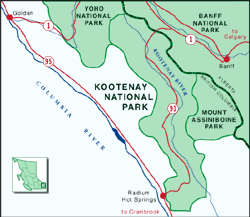
Click on the map to view an enlargement
|

Within Kootenay's 90 km (56 mi) length a dramatic shift in elevation takes place which provides a surprising diversity of habitat. A colder, wetter climate in the north results in forests of Engelmann spruce, subalpine fir, and plateaux of alpine tundra beneath snowy glaciers. In the south, the hotter, drier climate supports forests of Douglas fir and lodgepole pine, and grasslands scattered with prickly-pear cacti.
Kootenay is home to a herd of a couple hundred Rocky Mountain Bighorn sheep, a significant number when their plight is considered. It is estimated that at the beginning of the century there were 1.5-2 million Rocky Mountain Bighorn sheep in this region. Habitat loss has hit the sheep hard, and their numbers have plummeted. In summer, sheep feed over a wide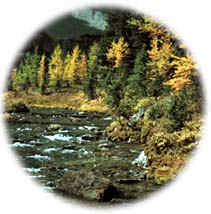 range, but in winter, severe conditions force them to move down to the valley bottom. Since this essential valley bottom habitat often represents only 10% of their total range, the loss of even a little can be devastating. In Kootenay National Park, this crucial habitat is in the same area as Radium Hot Springs, and some of the most critical sheep habitat is actually outside the park's boundaries. range, but in winter, severe conditions force them to move down to the valley bottom. Since this essential valley bottom habitat often represents only 10% of their total range, the loss of even a little can be devastating. In Kootenay National Park, this crucial habitat is in the same area as Radium Hot Springs, and some of the most critical sheep habitat is actually outside the park's boundaries.
In response, a project called 'Bighorn in our Backyard' has been created, involving local citizens who volunteer to monitor the movements and health of the sheep herd. The project is a joint partnership between Parks Canada and the town of Radium Hot Springs. Keeping a watchful eye on the sheep is important in preventing the impact the development of the town could have on the last winter feeding range the sheep have.
Besides the sheep, the most common wildlife in Kootenay are mule deer, elk, white tailed deer, and mountain goats. Less commonly seen are moose, black bears, grizzlies, wolves, coyotes, snowshoe hares, and marmots.
The birds who make this region their year-round home include the mountain chickadee, ruffed grouse, golden eagle, gray jay, white-tailed ptarmigan, red crossbill, and one of North America's largest concentrations of ospreys. Summertime visitors include the ruby-crowned kinglet, American robin, Audubon's warbler, varied thrush, and mallard.
|
"A welcome and relaxing rest for weary travellers, the natural hot springs also feature fascinating pictographs left by natives who stopped to enjoy the hot waters centuries ago."
|

The scenic Kootenay Parkway (Highway 93), that passes through the park from north to south is one of the main attractions of the park. Many travellers stop at the numerous picnic sites and view points along the highway, gazing at the splendor of the surrounding peaks and glaciers. But for those who wish to really explore Kootenay, there are many more adventures and views found off the highway. Over 200 km (120 mi) of trails, ranging from short day hikes to longer overnight treks, provide the best ways to truly experience Kootenay's wildness.
Hiking
Trails of various lengths lead to some of the most interesting points in the park. Some of the most popular include the Paint Pots, Marble Canyon, and the Stanley Glacier. For short descriptions of these, and several other short trails, click here.
For visitors with the time and experience, there are several longer trails as well. Longer day hikes and overnight trips are described in the Kootenay National Park Backcountry Guide.
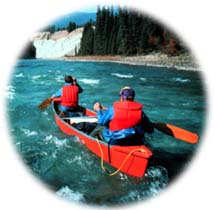
Radium Hot Springs
These relaxing and restorative pools were considered sacred to the aboriginal people who first enjoyed this area. The pools are a result of a crack in the earth's surface along a fault line that runs more than 2 km (1.2 mi) deep. As rain and meltwater seep down toward the earth's hot core, they are heated and pushed back up to the surface. Originally native people dug pools out of the gravel. Today, both a modern hot soaking pool and a cooler swimming pool.
Camping
Kootenay Park has 3 campgrounds with a total of 209 sites, available on a first come first served basis: McLeod Meadows, Redstreak, and Marble Canyon. A fourth campsite, Crook's Meadow, is a group campsite with room for up to 30 tents. It is possible to reserve this campsite. For information click here.
|
"Keeping a watchful eye on the sheep is important in preventing the impact the development of the town could have on the last winter feeding range the sheep have."
|

The Kootenay National Park area has been used by travellers for thousands of years. Both plains and mountain Native groups came to use the hot springs and to collect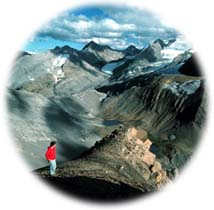 paint from the Paint Pot beds for use in their art and ceremonies. paint from the Paint Pot beds for use in their art and ceremonies.
More recently the Hudson's Bay Company dispatched a number of explorers to the region to find trade routes to the Columbia River and Pacific Ocean. Eventually homesteaders and miners settled in the area. Word of the hotsprings spread, and the first pool and bathhouse were built in 1911.
The local population grew, but still had no reliable road or rail connection with the nearest city, Calgary. The federal government offered to build a much needed road through the Rockies if the provincial government would give up the land on either side of the highway for preservation. The BC provincial government agreed, and in 1920 Kootenay National Park was created.
|
|
Return to the Kootenay Rockies Region
Become Involved!
|
|

